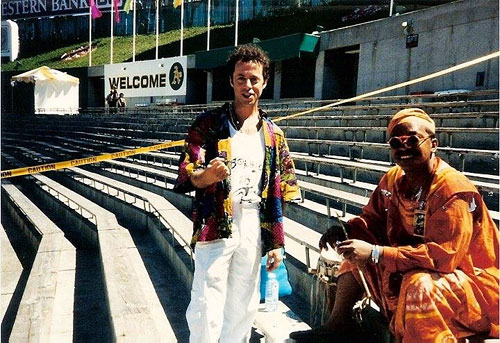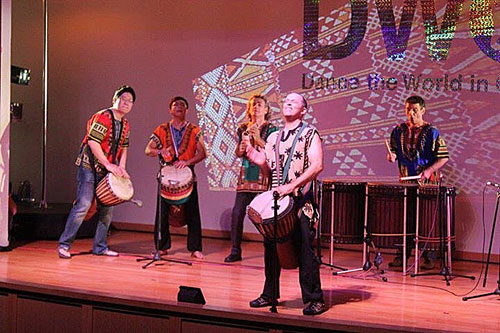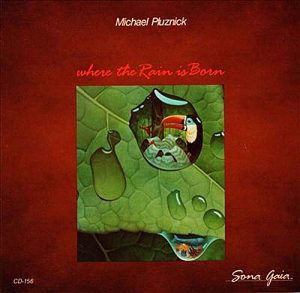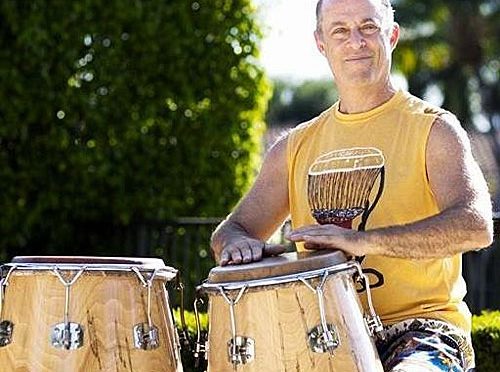Les Moncada Chats With Conguero And Djembefola Drummer Michael Pluznick
Francisco Aguabella once told me, “I do not play the drum, I have lived the drum”. Remembering that phrase, it’s great when one’s daily line of work is drumming for a living, teaching drum lessons and or even selling drums and miscellaneous supplies to drummers, or as a musician full time.
Michael Pluznick is such a drum master, who has been learning and teaching drumming all his life. What a dream job! Any drummer would actually die for! Michael is constantly traveling worldwide, teaching drumming classes and playing with the legends of drums for example djembe drum legend Bolokada Conde.
Michael was born in Elizabeth, New Jersey, but he presently resides in Delray Beach, Florida. Michael travels extensively to Asia and Africa and soon will be voyaging on his third trip to Cuba soon!
I became familiar with Michael when a group of young drummers decided to go to Cuba in 1985 for a venture. They wanted to learn more, had exhausted their resources in the San Francisco Bay Area and decided to go to Cuba.
During this trip to Cuba, they studied with the masters and brought back videos that knocked everyone’s socks off. I was one of the sponsors of the group, as an aspiring Latin percussionist also wanting to know more and more.
Michael and his group recorded the famed Changuito timbales solo in front of the hotel in Cuba, saw the show by Juan De Dios, quinto conga drummer and dancer, and met Pello El Afrokan who is the inventor of the Latin rhythm Mozambique, made famous by Pello, pianist Eddie Palmieri and timbalero legend Manny Oquendo.
Pello then invited them to his apartment for batá lessons and a rumba, with elder batá legend, Amado Gomez present. At a certain point, the legendary Afro Cuban rumba singer Carlos Embale walked in. There is a video of this session that might be recovered in the future. I no longer have this video personally.
Michael and the group also met and associated with the Conjunto Folklórico Nacional de Cuba and batá elder Carlos Aldama, who was the lead batá drummer for the Cojunto Folklorico. Today, Carlos Aldama resides in the San Francisco Bay Area, and sometimes on a whim, I have wondered, that if that trip inspired musicians to move to the USA and the San Francisco Bay Area.Let’s see what Mr. Pluznick has to say:
Les Moncada – Michael what is your family background?
Michael Pluznick – My family is of Russian descent, via Poland. My grandfather moved here to the USA prior to World War II.
When was the first time you actually heard percussion and realized that it interested you and that you would have a love for drums?
My father was able to get us free trips to Puerto Rico in the 60s when it was first becoming a tourist location. I wandered on the beach and heard drummers there for the first time as a small child. At our hotel, there was a band with a bongo player. I will never forget one Christmas there they were giving out presents and they gave my friend some tack head bongos. I was so disappointed I did not get them! Hounded my father for several months until he was able to find me a Mexican tack head drum and later he got me one with actual hardware.
How did you start studying drums, who were your teachers?
At the time I first started playing in 1967. There were no Cuban teachers in my area in New Jersey, so I took drum set lessons and learned basic fundamentals from a drum set teacher at a nearby music store. I had no technique, no slap and tone but I loved how it felt to play and practiced to Santana and Olatunji records.
I played in several bands as a thunder drummer not knowing how brutal I was! In 1975 I was at art school at RISD in Providence Rhode Island playing in the school jazz band. I met a local conga player, someone who told me I needed to study, that I would never learn, if I did not listen to people better then me.
At first I thought he was crazy. And then I had an epiphany, a realization that I had two possible paths I could partake on; one as a percussionist and hand drummer or one as an artist. I realized the path as a drummer would be incredibly difficult but in that moment of realization I decided to drop out of art school and pursue a path as a drummer.
I contacted a close friend of mine who was a very good player, George Terzis for lessons. He showed me how to hit the drum correctly and told me there was an actual language to playing drums. He introduced me to Gail Philipo in Boston. She had studied with several master drummers and she was able to give me a solid foundation in the concepts of traditional drumming from Cuba and West Africa.

After Boston I went to California where I studied full time with Simbo (Craig Goodman) as well as several local teachers there at the time including lessons with Marcus Gordan, Tobagi, Luis Cespedes among others.
My son moved to New York where I visited often and I started studying with John Amira who taught me Haitian drumming as well as Afro Cuban drumming for a few years. He wrote everything out in box notation so he got me into that as well.

I got a job as the percussion salesman at Haight Ashbury Music Center, (San Francisco) after the change of owners from Chickens That Sing Music. That was 35 years ago!
While I was at the shop I would often practice on the many conga drums that were there. Armando Peraza would stop in regularly and we would have a jam session. He would quiz me on each rhythm I would play for him and then he would solo. The shop would completely fill up with a hundred or more people every time he got down to business! It was an amazing experience.
Armando had a friend an African American friend named Ray Gardener (he wrote” Dance Sister Dance” for Santana). Ray would come in often to the shop and he invited me to record with him and Raphael Ramirez in the studio, which was my first experience recording. He and I had intellectual debates on traditional music vs. making world music combining traditional with non traditional.
Tell me about your trip to Cuba.
I had a friend named Jerry Shilgi, who passed away a while back. I met Jerry in the yard at Sproul Plazz in Berkeley California where there were jam sessions on Saturday and Sundays. I would not call them a drum circle, but something like that. Jerry introduced me to my teacher Simbo who played both traditional Afro Cuban and West African styles.
Jerry was connected to everyone and everything at that time.
We became roommates in China town in San Francisco. He found out about the trip to Cuba. No one we knew had gone before and it was a no brainer for me. I had to go.
I was able to acquire one of the first non commercial video camcorders to film with. We went officially as members of an educational group going to the Jazz Festival in Varadero (Cuba). While we were in the coffee shop at our hotel the first day we were there we saw the legendary Pello El Afrokan. We were there with Rob Holland and Bret Golin.
We asked him if we could study with him (Pello) while we were there and he agreed to not only teach us, but he basically brought us around and introduced us to everyone in the music and drum scene you can imagine, as well as set up classes with us for rumba, mozambique and batá. We even had a rumba with Carlos Embale singing in Pello’s apartment!
We were able to sit in at the Saturday Rumba with Conjunto Folklorico Nacional as well as many of the famous night clubs and bands that were playing there at the time, as, Pello was so well respected. We barely slept and I remember several times passing out on the bed with all my clothes still on and waking up early with Pello waiting for us outside.
How did you get involved with the djembe drum?
My teacher Simbo insisted we study West African rhythms as he taught us that all rhythms on congas were somehow rooted in and related to West Africa.
At the time there were no commercial djembes available so we were taught to make and skin our own drums.
Also, one thing a lot of people today do not realize is that in the mid-late 70’s there were no internet, CD’s or information readily or easily available. Plus most teachers were very secretive at the time for various reasons.
The rhythms, parts and arrangements were simply not out there like they are today. There were very few records available and there were not a lot of groups performing traditional music from Cuba, Africa or Haiti.
Professional percussionists and die hard students would learn any rhythm or percussion piece that came through. There was so little information compared to today. So therefore, many of us learned and played whatever came to us, or whatever we could find. There was not as big of a separation in styles as there is today. And if you wanted to get work you needed to be versatile in many styles.

Michael, who have you performed with or studied with, djembe wise?
I started with Simbo, then I took lessons with whoever would come through locally in the Bay Area including a talented griot named Karamba Diabate. When Abdoulaye Diakité came to the Bay Area, things changed drastically as he was open to and taught both women and white people. I personally believe that Abdoulaye is almost single handily responsible for the birth and explosion of the djembe in the USA. His philosophy is “Djembe Bara” or “unity of the drum”. He spent a lot of time in Santa Cruz where Drumskull Drums was born and many teachers came out of.
The next wave of djembe related music and drumming came with Mamady Keita who I studied with, in group scenarios as well as Mabiba. Wade Peterson a student of both also tutored me regularly for a couple of years.
I moved to Maui, Hawaii where I got to study with Mohamed Camara, M’Bemba Bangoura, Dame Gueye and many others who would come through on extended stays.
When I moved back to the Bay Area about 15 years ago I was able to study with and then perform with several groups. The most notable is Bolokada Conde from Guinea West Africa.
While I was living in the Bay Area, my chiropractor told me he wanted to record some music. I had a friend who was an engineer at Bear West Studios in downtown San Francisco. I took the chiropractor to the studio and helped organize the session. This was the start of me producing and recording regularly in studios. I was eventually able to play on several rock and pop albums and created several of my own recording studios and music and drumming CDs over the years.
I recorded and performed with members of The Grateful Dead, Clarence Clemons (from Bruce Springsteen), The Tubes, Todd Rundgren and some other pop stars in the Bay Area over the years. In the 80’s i was able to get a recording deal on the Narada label for 4 CDs of my own world music combining traditional themes with western instrumentation as well. You can see and listen to samples of all my stuff on my website: www.michaelpluznick.com
I see that your travel all over the planet, which I think is great. Do you teach, give clinics and can you mention the different locations that you travel to, can you tell me more about this.
Yes, 25 years ago I started to travel to Asia and fell in love with it. I also started going to India on various pursuits. I started bringing my drums here, both congas and djembes and found the local pockets of friendly and curious drummers.
Most drummers here in Asia are talented and self taught, these days from the internet. One thing led to another and I started to share and teach wherever I went. People here are appreciative like I was and still am when someone shows me something I don’t know.
When I can I sit in with the local jazz or funk groups for fun. Of course the musicians are struggling here so it is not a great place to gig.
Michael who is your all time conga drummer?
My favorite conga layer who I actually played with is Armando [Peraza]. I also love his bongo work. My favorite recording conga player is Mongo Santamaria. I love Giovanni and Richard Flores. They have taken it to a whole new level. I used to listen to a lot of Los Papines, they were my favorite for a while, especially Luis. Then of course there is Patato! And Daniel Ponce.
How do you pick one? Thomas Cruz really has super cool stuff…there are so many fantastic and unbelievable players I love… but for me, what rocks my world is old school, deep pocket and groove. Maybe I am just getting old!

Who is your favorite bongo drummer?
Bongo… again it’s Armando and Dandy. I saw Karl do a bongo and an amazing bell solo the other day and I was quite impressed. I feel his playing has sky rocketed as well.
How about your favorite timbales drummer?
Timbales… I am an Orestes fan as well as Changuito. And I do love Chepito as well. He ripped in the day! The first time I saw Changuito was with Los Van Van in Cuba in 1985. I was filming them and standing behind him. I had no idea who he was in those days. Rob Holland did, but I did not. He was not an international sensation then.
Anyway, he did about a 15 minute solo and I filmed the whole thing. I had never heard anyone play like that except maybe Elvin Jones. So outside, so revolutionary”. All I can say is he blew me away!
Michael, who is your favorite djembe player?
Bolokada Conde and M’Bemba Bangoura for Guinea style; Abdoul Doumbia and Moussa Traore for Mali style; Dame Gueye for Senegalese; and Dr Jobi for Ivory Coast style. These are all older and some people consider “old school” style. There are several super hot young players who I listen to but I prefer to study with and play the older style(s).
Of all the drums and instruments you play, which is your favorite and why?
I cannot honestly say I have a favorite, I love congas, bongos, shekere and djembe. I practice and play as much as I can. These days, I suppose, because of the popularity of drum circles I get most of my students wanting to learn djembe so as far as work, it is almost always on djembe these days.
For me it is all related. When I study Malian music (I lived in Mali 2 times) I hear the roots and a direct undeniable connection to Afro-Cuban drumming. It is so plain and clear!
The 6/8 (or 12/8) bell, the root to all the drumming we do is in every drum music that comes out of the West African diaspora be it Cuban, Haitian, Brazilian or other regions in the new world. It is all connected and so are its instruments.
What is the future for master drummer, teacher Michael Pluznick? Recordings, lessons, travel?
Ha, ha, ha. Brother, I am not even close to mastering anything. Fortunately, I have contact to and I am able to study with masters, and I see them online.
Mastery is a far off place for me. I am happy and will always be happy to be a student of this fine art and I am motivated to continue learning and studying every day.
I feel I have very good methodology for sharing and teaching, I can help people so I teach. I continue to record projects whenever I can and whenever there is a opportunity. I love traveling and hopefully with God’s help I will continue to do so.
I would like to thank Michael Pluznick for his time with this interview due to his busy schedule and wish him the world of the best in the “spirit” of drumming for many years to come!
Solo music-shop:

Michael Pluznick – Where the Rain Is Born (Sona Gaia, 1989)

